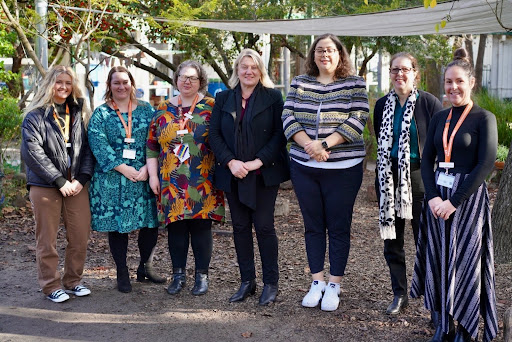Utilising the arts as a learning tool: lessons from Gowrie Clare Court

The arts have long been recognised as an important learning tool and vehicle for fostering creativity. Whether it’s listening to music, exploring creative mediums such as paint and clay, engaging in dramatic recreations, creating stories or admiring and appreciating the work of accomplished artists, early childhood education and care (ECEC) is ripe with opportunity to learn and grow through art.
Educator Sarah Gardiner recently shared her thoughts on how this learning plays out at Gowrie Clare Court, focusing on the work done in the service studio.
Studio work, she said, is ‘vast and varied’, with a strong focus on process, rather than product. By engaging in the process of creating art, rather than the end product, children develop creativity, a skill which she believes helps them with divergent thinking and cognitive skills, such as problem-solving.
Fellow educator Gini Merange agreed, saying the arts allow children to communicate more complex ideas and thoughts in a direct way. “They also help connect what’s happening in the classroom to a broader audience.”
Process versus product
Process art focuses on the creative thinking of children, which allows them the freedom to imagine and experiment. In contrast, asking children to create a certain product, based on preconceived ideas, stifles imagination and can cause frustration, Ms Gardiner said.
“It’s more about how you think. We might teach or demonstrate how to use different mediums, but we set the children up so they can then break the rules.”
The process at Clare Court often involves introducing the children to culture, whether it’s listening to classical music, watching clips of Bangarra Dance Theatre, or studying individual artists.
Children at the service were recently inspired by Yayoi Kusama’s Obliteration Room, creating their own ‘obliteration space’ at the service.
“It was an amazing group piece where we worked collaboratively, exploring the idea that we’re all tiny dots in the universe – individual, but all connected,” Ms Gardiner shared. “Other groups contributed to the work and we had lots of interesting conversations.”
Prompts and provocation
Ms Merange said that for children who are hesitant to engage with “a blank canvas”, or who don’t know how to get started when given free range to engage with art materials, small provocations can be supportive.
“It might be a large piece of paper that we’ve drawn a wavy line down the middle of,” she explained. “Children can then take it in any direction they like.
“Recently we had a log set up with clay for the children to work with and found them making little mushrooms and fairy doors for the log. It’s about leaving things open enough so there’s no wrong way for it to be done.”
Another idea is to provide a limited colour palette, something she tried recently when engaging the children in a series of bird paintings, following the Aussie Backyard Bird Count.
“Something really shifted in the way the children viewed the project and we saw a lot of detail coming out through the use of those few colours,” she explained.
Modes of expression
When it comes to different mediums, Ms Gardiner said at Clare Court “anything goes”.
“We use a lot of watercolours, pastels and charcoal, and have started doing collage, using leaves and flowers we find on the ground when we’re out and about,” she said. “Here, we’ve been inspired by Jeannie Baker’s children’s books, including Circle, Window, and Where the Forest Meets the Sea.”
For Ms Merange taking art equipment such as watercolour paints outside inspires children to use them in different ways. “They will paint on the logs or found materials, or fallen leaves and sticks. The process develops with the environment they’re in,” she explained.
Material world
Early Childhood Teacher Carley Rawle has studied fine art and art therapy, as well as the Reggio Emilia approach, and believes there is a strong interplay between the creator and the materials.
“We let the materials and children speak during the creative process and we listen to what the materials can teach us about our relationships to the environment,” she said.
Ms Rawle believes teachers and students navigate curricula content through the arts, which then allows children to manifest their creative thinking.
Fabric, music, light, paint, floor and children were part of a recent project she introduced at Clare Court, which allowed for “a multiplicity of expression”. Her reflection on the project appears below:
In the studio, paint moves along the floor, circular lines (re)configure our ideas of what painting is as bodies’ roll, step, bend, sway, twist, and twirl with brushes. Children improvise and dance in motion with fabric. Inspired, children co-compose the life worlds of local insects, fabric spins, cocoons and hives transpire. The resonance of spring is felt as colour enlivens memories of family holidays; palm trees emerge in pencil.
In these moments teachers question how might movement generate visual arts practices? What will experimental pedagogies teach us about how children learn? Importantly, the studio activates emerging material-child encounters that situate children as artists and researchers in relationship with the world.
To learn more about the importance of the arts in ECEC settings, please see here.
Popular

Quality
Research
Workforce
Empowering safeguarding in early childhood: ECA’s comprehensive resource suite
2025-09-11 07:00:57
by Fiona Alston

Workforce
Practice
Quality
Research
Supervision and team culture: Safeguarding trust through shared responsibility
2025-09-09 07:26:32
by Fiona Alston

Provider
Quality
Practice
Workforce
KU’s Megan Dodds named finalist in 2025 HESTA Early Childhood Education & Care Awards
2025-09-15 10:22:14
by Fiona Alston
















